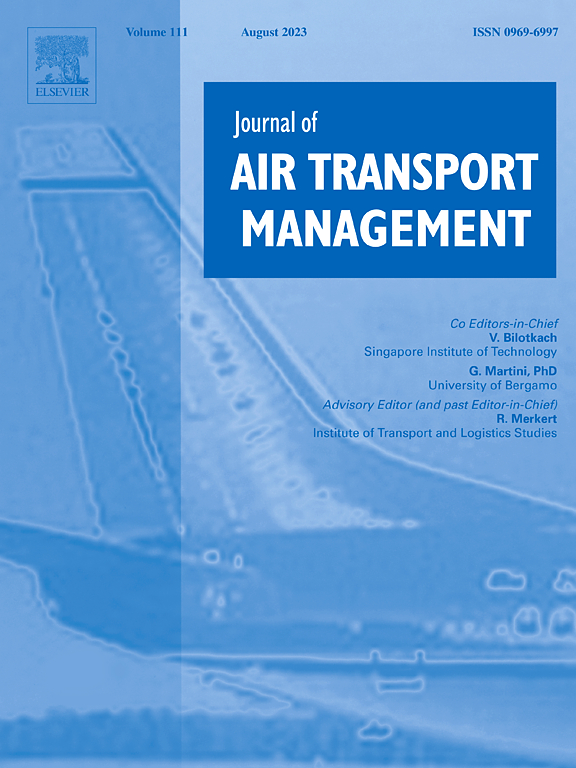A novel slot optimization model for congested airports integrating IATA priority and operational priority
IF 3.9
2区 工程技术
Q2 TRANSPORTATION
引用次数: 0
Abstract
The Worldwide Slot Guidelines (WSG) are currently widely adopted for airport slot demand management. In some busy airports, coordinators are responsible for allocating slots according to the priority order outlined by the WSG. Particularly, historical slots with the highest priority should be directly allocated to the airline carrier holding that slot in the following same season. However, when airport capacity decreases, there may be situations where historical priority slots cannot be met, rendering the existing allocation guidelines ineffective. Currently, no research considers this situation. To complement the existing coordination priority, this paper first defines a new priority category from an operational perspective, referred to as operational priority. Furthermore, a weighted dual-objective slot optimization model is constructed, integrating both coordination priority and operational priority within the same optimization model framework. A constraint-based hierarchical search strategy is adopted to find the optimal results for different priority slots. Applying the model to Shanghai Pudong International Airport (ZSPD) in China, experimental results show that the proposed model can effectively meet the requests of airlines, with a slot adjustment amount of only 3.15% and a maximum displacement of fewer than 40 min. Since the proposed model considers operational priority, the optimized results regarding temporal and spatial distribution are more reasonable, effectively reducing flight delays and improving operational efficiency.
基于IATA优先级和运营优先级的拥挤机场机位优化模型
全球时段指南(WSG)目前被广泛用于机场时段需求管理。在一些繁忙的机场,协调人员负责根据WSG列出的优先顺序分配机位。特别是,具有最高优先级的历史机位应该直接分配给在下一个相同季节持有该机位的航空公司。但是,当机场容量减少时,可能会出现无法满足历史优先插槽的情况,从而使现有的分配指导方针失效。目前,没有研究考虑到这种情况。为了补充现有的协调优先级,本文首先从业务角度定义了一个新的优先级类别,称为业务优先级。在此基础上,构建了将协调优先级和运行优先级整合在同一优化模型框架内的加权双目标优化模型。采用基于约束的分层搜索策略寻找不同优先级槽的最优结果。将该模型应用于中国上海浦东国际机场(ZSPD),实验结果表明,该模型能有效满足航空公司的需求,航段调整量仅为3.15%,最大位移小于40 min。由于该模型考虑了运营优先级,优化结果在时空分布上更加合理,有效减少航班延误,提高运营效率。
本文章由计算机程序翻译,如有差异,请以英文原文为准。
求助全文
约1分钟内获得全文
求助全文
来源期刊

Journal of Air Transport Management
TRANSPORTATION-
CiteScore
12.40
自引率
11.70%
发文量
97
期刊介绍:
The Journal of Air Transport Management (JATM) sets out to address, through high quality research articles and authoritative commentary, the major economic, management and policy issues facing the air transport industry today. It offers practitioners and academics an international and dynamic forum for analysis and discussion of these issues, linking research and practice and stimulating interaction between the two. The refereed papers in the journal cover all the major sectors of the industry (airlines, airports, air traffic management) as well as related areas such as tourism management and logistics. Papers are blind reviewed, normally by two referees, chosen for their specialist knowledge. The journal provides independent, original and rigorous analysis in the areas of: • Policy, regulation and law • Strategy • Operations • Marketing • Economics and finance • Sustainability
 求助内容:
求助内容: 应助结果提醒方式:
应助结果提醒方式:


